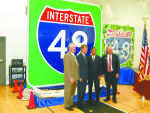U.S. 71 officially becomes Interstate 49

By James R. Campbell
Nevada Daily Mail
JOPLIN -- History was lauded with Wednesday's observance of the conversion of U.S. 71 Highway into Interstate 49 from Kansas City to Pineville.
On the 12th day of the 12th month in 2012, a date that will only occur once in the 21st Century, 275 people gathered in a temporary building at the new Joplin East Middle School to hear U.S. Sen. Roy Blunt, R-Mo., Federal Highway Administrator Victor Mendez of Washington, D.C., and other speakers tell the Show-Me State's decades-old story of I-49.
Just as the Troop D Honor Guard of the State Highway Patrol marched in to present the colors and start the noon event, Missouri Department of Transportation crews began running the 190-mile stretch to uncover more than 1,300 I-49 signs, or "shields," said Southwest District Engineer Becky Baltz of Springfield.
Baltz said the last interstates built in the state were I-64 in 1988 at St. Louis, which was extended last year, and I-44, which runs past Joplin, in the 1950s and '60s.
Blunt detailed working on upgrading U.S. 71 and its inclusion in the interstate system while he was a Springfield congressman from 1997 to 2010.
"This is something people here have been talking about for 50 years," the senator said, explaining that it was a struggle to get Congress to designate I-49 a "high priority corridor" and obtain $250 million, or half the total cost of the conversion on which construction began in the late 1990s.
"Today, as the covers come off the signs, the national priority becomes a national reality," Blunt said to applause from the standing-room-only crowd.
Referring to the city's catastrophic tornado strike of May 22, 2011, he said the middle school, with construction still in progress, is an example of Joplin residents' determination "to think about Joplin tomorrow and not Joplin yesterday."
Recounting the Federal Highway Administration's long involvement in the project, Mendez said, "Things in today's world cannot happen if people don't work together.
"Once you have access to this interstate system, you have access to the rest of the United States and the world."
Mendez said the route will forward a goal that President Obama, having visited here twice since the tornado killed 161 people and wreaked $2.2 billion in property damages, has often expressed "to get people back to work."
Missouri Highways and Transportation Commission Chairman Rudolph "Rudy" Farber of Neosho described often traveling to Kansas City as a young man, when the road was comparatively primitive and the trip took "5 1/2 hard hours.
"My wife and I drove it the other day and it was an easy 2 1/2-hours," Farber said. "That's what I call progress."
The hour-long event was highlighted by the unveiling of an imposing symbolic I-49 sign by Blunt, Mendez, Farber and MoDOT Director Kevin Keith, punctuated by the Joplin East Middle School Band's performance of the National Anthem, "God Bless America" by the school's sixth grade choir and a medley of songs by its show choir.
The speakers came to the podium before the backdrop of a colorful I-49 collage done by MoDOT employees, Keith noted.
Acknowledging official state delegations from Arkansas and Louisiana, Keith said his department is optimistic that the long-awaited first two lanes of a crucial I-49 bypass at Bella Vista, Ark., will be constructed now that Arkansans approved a half-cent sales tax to finance transportation projects in the Nov. 6 election.
Baltz had said the Bella Vista project will further advance plans to extend I-49 southeast from Lafayette, La., to New Orleans and north from Shreveport, La., to Kansas City, linking Louisiana seaports to the Canadian border in North Dakota on I-29 and other northern points on I-35.
